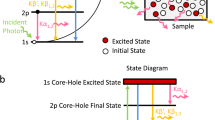We present the results of measurements on a single crystal sample of scandium metal at temperatures down to 100 ΜK using nuclear quadrupole resonance (NQR). We find two regimes in the relaxation curves: an initial fast relaxation, followed by a slower relaxation consistent with the three exponential recovery expected for an I = 7/2 system in zero external magnetic field. The Korringa constant for this longer time relaxation in our sample is 90 +- 9 msec K−1. By observing deviations in the ratio of the intensities of adjacent nuclear spin transitions at the lowest attainable temperatures, we have been able to make a determination of the sign of the total electric field gradient present in the crystal. We find that the lowest energy state of the nuclear spin system corresponds to m I = +-7/2. A combination of these deviations and pulse NQR allows us to use this system as an absolute thermometer in the ΜKelvin regime.
Similar content being viewed by others
References
J. Korringa, Physica 16, 601 (1950).
A. Narath, Phys. Rev. 162, 310 (1967); T. Asada and K. Terakura, J. Phys. F 12, 1387 (1982).
D. E. MacLaughlin, J. D. Williamson, and J. Butterworth, Phys. Rev. B 4 60 (1971).
J. W. Ross, F. Y. Fradin, L. L. Isaacs, and D. J. Lam, Phys. Rev. 183, 183 (1969); A. Narath and T. Fromhold Jr., Phys. Lett. 25A, 49 (1967); Y. Masuda, J. Phys. Soc. Jap., 26 1058 (1969).
M. Goldman, Spin Temperatures and Nuclear Magnetic Resonance in Solids, Clarendon Press, Oxford (1970).
M. T. Hiuku, M. T. Loponen, T. A. Jyrkkio, J. M. Kyynarainen, A. S. Oja, and J. K. Soini, in Proceedings of the 17th International Conference on Low Temperature Physics (North-Holland, Amsterdam, 1984), p. 133.
K. Gloos, P. Smeibidl, C. Kennedy, A. Singsaas, P. Sekowski, R. M. Mueller, and F. Pobell, J. Low Temp. Phys. 73, 101 (1988).
R. G. Barnes, F. Borsa, S. L. Segel, and D. R. Torgeson, Phys. Rev. 137, A1828 (1965).
M. H. Cohen and F. Reif in Solid State Physics, F. Seitz and D. Turnbull, eds. (Academic Press, New York, 1958), Vol. 5, p. 321; T. P. Das and E. L. Hahn in Solid State Physics, F. Seitz and D. Turnbull, eds. (Academic Press, New York, 1958), Suppl. 1, p. 58.
G. Fricke, H. Kopfermann, S. Penselin, and K. Schlupmann, Naturwiss. 46, 106 (1959).
F. W. de Wette, Phys. Rev. 123, 2070 (1961).
T. P. Das and M. Pomerantz, Phys. Rev. 123, 207 (1961).
H. Ernst, E. Hagn, E. Zech, and G. Eska, Phys. Rev. B 19, 4460 (1979).
Y. Tang, E. D. Adams, K. Uhlig, and D. N. Bittner, J. Low Temp. Phys. 60, 351 (1985).
M. Bloom, E. L. Hahn, and B. Herzog, Phys. Rev. 97, 1699 (1955).
M. Bloom and R. Norberg, Phys. Rev. 93, 638 (1954); E. L. Hahn and B. Herzog, Phys. Rev. 93, 639 (1954).
G. Eska, J. Low Temp. Phys. 73, 207 (1988).
L. Pollack, E. N. Smith, R. E. Mihailovich, J. H. Ross Jr., P. Hakonen, E. Varoquaux, J. M. Parpia, and R. C. Richardson, Physica B 165 & 166, 793 (1990).
See references within reference 9. M. H. Cohen and F. Reif in Solid State Physics, F. Seitz and D. Turnbull, eds. (Academic Press, New York, 1958), Vol. 5, p. 321.
N. S. Sullivan, Bulletin of Amer. Phys. Soc. March 1989, p. 736. P. M. Anderson, N. S. Sullivan, M. Rall, and J. P. Brison, Physica B 169, 453 (1991).
Oxford Instruments Ltd., Osney Mead, Oxford OX2 0DX, U.K.
Ames Labs, Iowa State University, Ames, Iowa 50011-3020.
Avantek, 3175 Bowers Ave., Santa Clara, CA 95054; Comlinear Corp., 4800 Wheaton Dr., Fort Collins, CO 80525; EMI filters from Erie Technological Products, Ltd., Trenton, Ontario, Canada—note we used 1233-000 type filters for the low frequency feedthrough application and 1217-000 filters for the transmit and receive feedthrough. They are not shown in the figure due to space constraints. Hewlett-Packard Co., 19310 Pruneridge Ave., Cupertino, CA 95014; Interface Technology, 2100-T East Alsta Ave., Glendora, CA 91740; Merrimac, P.O. Box 986, 41 Farfield Place, West Caldwell, NJ 07007; Mini-Circuits, P.O. Box 166, Brooklyn, NY 11235; North Hills Electronics, 1 Alexander Place, Glen Cove, NY 11542; EG&G Princeton Applied Research, P.O. Box 2565, Princeton, NJ 08543; Tektronix Inc., P.O. Box 500, Beaverton, OR 97077; Wavetek, 5808 Churchman Bypass, Indianapolis, IN 46203.
J. Lepaisant, D. Bloyet and E. Varoquaux, Rev. Sci. Inst. 55, 4, 521 (1984).
D. Greywall, Phys. Rev. B 33, 7520 (1986).
California Fine Wire Sigmund Cohn, Mt. Vernon, NY.
B. G. Turrell, G. Eska, N. Masuhara, and E. Schuberth, J. Low. Temp. Phys. 70, 151 (1988).
P. Bernier and H. Alloul, J. Phys. F: Metal Physics 3, 869 (1973).
T.-W. E. Tsang and K. A. Gschneidner Jr., J. Less-Common Metals 80, 257 (1981).
T.-W. E. Tsang, K. A. Gschneidner Jr. and F. A. Schmidt, Proceedings of the 12th Rare Earth Research Conference, C. E. Lundin, ed. (Denver Research Institute, 1976), Vol. II, p. 847.
F. Y. Fradin, Phys. Rev. B 5, 1119 (1972).
H. Benoit, P.-G. de Gennes, and D. Silhouette, Comptes Rendus 256, 3841 (1963).
A. G. Anderson and A. G. Redfield, Phys. Rev. 116, 583 (1959).
Author information
Authors and Affiliations
Rights and permissions
About this article
Cite this article
Pollack, L., Smith, E.N., Parpia, J.M. et al. Determination of the electric field gradient and relaxation time measurements in scandium metal at very low temperature. J Low Temp Phys 87, 753–772 (1992). https://doi.org/10.1007/BF00118333
Received:
Revised:
Issue Date:
DOI: https://doi.org/10.1007/BF00118333




